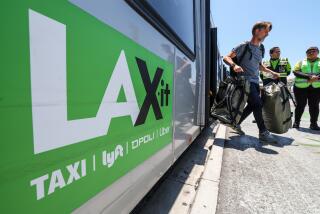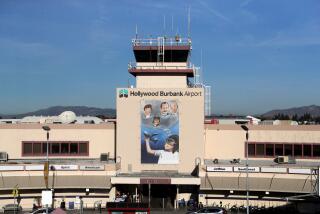Tough Times in the Wind : Aviation: Van Nuys Airport is being buffeted by a declining profit, tenant pressures and noise complaints.
From his office overlooking the runway at Van Nuys Airport, Ron Kochevar points to a helicopter flickering through the murky skies and shrugs.
âHere comes a sheriffâs helicopter,â the 46-year-old airport manager said with resignation. âAll itâs doing is traversing the area, going from one point to another through the Valley. And now, weâll get another complaint.â
If Kochevar sounds beleaguered these days, he has good reason.
Buffeted on the one hand by noise complaints from San Fernando Valley residents and on the other by tough economic conditions and pressure from airport tenants such as billionaire David Murdock, who wants to expand, Van Nuys Airport is in a tailspin.
With 1,400 takeoffs and landings a day, the Los Angeles city-owned airport remains the busiest general aviation airfield in the nation. But the airportâs profits have been in a nose dive. Van Nuys Airport will lose money in the fiscal year that ends June 30, contrasted with a profit of $185,000 last year and $1.2 million in 1989.
Meanwhile, takeoffs and landings at the airport dropped last year and are down another 5% so far this year. Small planes continue to flee Van Nuys for other airports, such as Pacoimaâs Whiteman Airport and Camarillo Airport, where tie-down rates are lower. As a result, the number of aircraft based at the 725-acre Van Nuys Airport stands at about 850, compared with more than 1,300 a decade ago.
There has been an increase in business jets garaged at Van Nuys, which boosted revenue in 1991 to a record $8.7 million, up 15% from 1987. However, with more jets have come a groundswell of noise protests. Whatâs more, aviation businesses at Van Nuys Airport complain that both the recession and airport policies are strangling them.
âItâs a constant worry and fight for anybody who works or has a business here,â said Clay Lacy, who has been involved with Van Nuys Airport as a pilot since 1952 and now runs a charter and aviation services company. âDoing business here gives you the feeling youâre on shaky ground.â
The airportâs problems partly reflect industrywide troubles. Many of the countryâs 400 major general aviation airports are grappling with the same issues, analysts say.
However, many blame Van Nuys Airportâs troubles on the Department of Airports, saying the city agency has long neglected the airport while focusing on the moneymaking operations at Los Angeles International Airport, which it runs along with airports in Ontario and Palmdale. Department officials say theyâre not at fault.
âWhat weâre trying to do is strike a balance between the communityâs concerns and the concerns of airport operations,â said Clifton Moore, the departmentâs longtime executive director.
Phil Berg, president of the Van Nuys Airport Assn., which represents 200 airport tenants and users, countered: âThere is no direction of where this airport is going.â
Airport users fault the Department of Airports for trying to parcel out pieces of the airport for non-aviation commercial development. âThe airport has been run in a haphazard, plot-by-plot way,â Berg said.
Two months ago, after pressure from City Councilman Hal Bernson, citizens groups and tenants, the Department of Airports agreed to begin work on a master plan that would, for the first time, detail the airportâs long-term plans. That plan will cover what kind of development the airport wants, noise restrictions, non-airplane commercial development and rental rates. Airport officials agreed to halt any further development until the plan is finished.
Business leaders, however, think that a moratorium will only make matters worse in the interim.
âYou canât kill an infant to get rid of the disease,â said Kipp Pritzlaff, chairman of the Mid-Valley Chamber of Commerceâs Airport Committee, which is trying to modify the moratorium. âItâs going to create chaos,â he said of the ban.
Pritzlaff and many others in the aviation community agree that it will take at least two years of fierce negotiations to formulate a master plan. And even then, many remain skeptical that the plan will solve the airportâs problems.
Julie Gerler, a consultant hired in April by the city to help develop a master plan, conceded: âThis is a longstanding conflict, and people have staked-out feelings. A consensus is not going to be easy.â
Certainly, the Department of Airports has made mistakes. Perhaps the biggest was a futile attempt in 1990 to put several office buildings on the 70-acre site of the former Air National Guard facility on Balboa Boulevard. After spending $400,000 on a study, the department shelved the project after homeowners protested about potential traffic tie-ups.
Indeed, the problems facing Van Nuys Airport have been in the making for years. And they involve the changing face of the airport, caused in large measure by the drop-off in general aviation manufacturing and the corresponding growth of corporate jets that have moved in.
In 1979, U. S. manufacturers shipped more than 17,000 general aviation aircraft. But since then, sales have plummeted to slightly more than 1,000 last year, a trend experts attribute to spiraling increases in product liability insurance, and price and maintenance of private aircraft. And shipments arenât expected to pick up soon.
During that same 12-year period, the number of jets based at Van Nuys Airport has grown fivefold. Aviation analysts say Southern California is home to about 235 business jets, and 100 of them are based at Van Nuys. Helicopters based at the airport have gone up from 21 in 1980 to about 55 today, and those caused resident complaints to rise last year.
Experts say corporations were drawn to Van Nuys because of its central location in the Valley, its long, 8,000-foot runway that is suited for jets, and the saturated conditions at Los Angeles International Airport, Burbank and other urban airfields. Jet users at Van Nuys include Litton Industries, Hughes Aircraft, Great Western, Sony Corp. and the Los Angeles Kings hockey team, which uses a Boeing 727. Airport sources say former junk bond king Michael Milken, corporate titan Kirk Kerkorian and Murdock all have jets based at Van Nuys.
But the arrival of the jet age at Van Nuys hasnât set well with neighboring homeowners, who speak about rattled windows and interrupted sleep. The airport has some limitations on night flights, but not enough for some.
âIâd like to see them do away with night flying,â said Richard C. Seydell, who has lived near the airport for 45 years. Other residents have called for strict noise standards that some airport users say, if enforced, would ground many of the jets at the airport.
In past years, corporate tenants have kept a low profile. But privately they worry about getting caught in what they see as a no-win battle with residents. âWeâre frustrated,â an official of one big corporation said. âOur business jet is very important to our operations. Itâs not a perk or a toy for executives. I donât think people understand that.â
While the building moratorium wonât affect at least one previously approved hangar project, by Petersen Aviation, it is likely to halt development of several other proposed projects, including one planned by Murdock.
The chairman of Dole Food Co. operates a Falcon 900 that is stored in a hangar owned by Murdock along the airportâs stretch of hangars that make up corporate row. But because the hangar is close to a residential area, sources said, Murdock canât taxi in and out of the hangar; his plane must be towed to the runway. So he has proposed building a new hangar and an office building next to it.
Carol Klein, a spokeswoman for Murdock, said last week that the company has completed an environmental study for those projects. âAnd weâre proceeding with plans,â she said, without elaborating.
Airport officials also face criticism from smaller businesses at the airport, which say the cityâs annual rental rate of $14,000 an acre for all aviation tenants, while affordable to corporations, is too much for them. The rate has doubled since 1980, and it is likely to go up in three years. And hangar operators complain about a 20% vacancy rate that they say will only grow if corporations are allowed to build more hangars, as some have proposed doing.
The sagging economy and the malaise in the general aviation industry have forced at least one Van Nuys maintenance facility to close recently, airport officials say, and last year American Fliers moved its flight training operations to Santa Monica Airport after a dispute with its lessor.
Residents, tenants and airport officials all hope that a master plan will change that. But many, including people who work for the Department of Airports, remain skeptical.
Kochevar, the airport manager, said the master plan is not going to meet everyoneâs needs. âThere are competing interests, and somebodyâs going to be unhappy.â
VAN NUYS AIRPORT AT A GLANCE
Although Van Nuys Airport ranks as the busiest general aviation airfield in the nation, both traffic and total aircraft based at the 725-acre airport have declined over the last decade. Meanwhile, the airportâs plans to expand have been indefintely delayed by increasing complaints from residential neighbors over the airportâs noise.
Takeoffs Aircraft* Revenue** & Landings 1991 509,620 854 $8.7 million 1990 528,110 845 $8.1 million 1989 507,003 935 $7.8 million 1988 468,779 Not available $5.1 million 1987 476,627 973 $4.5 million
Takeoffs Profit** Noise Complaints & Landings 1991 $185,000 955 1990 $109,000 734 1989 $1.2 million 1,508 1988 $1.4 million 1,367 1987 $1.0 million 1,242
*Planes, jets and helicopters based at Van Nuys **For fiscal years ending June 30
Source: L.A. Dept. of Airports
More to Read
Inside the business of entertainment
The Wide Shot brings you news, analysis and insights on everything from streaming wars to production â and what it all means for the future.
You may occasionally receive promotional content from the Los Angeles Times.








